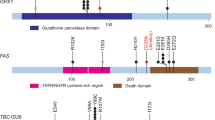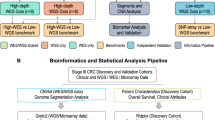Abstract
We report chromosome 3p deletion mapping of 32 cervical carcinoma (CC) biopsies using 26 microsatellite markers located in frequently deleted 3p regions to detect loss of heterozygosity and homozygous loss. In addition, two STS markers (NLJ-003 and NL3-001) located in the 3p21.3 telomeric (3p21.3T) and 3p21.3 centromeric (3p21.3C) regions, respectively, were used for quantitative real-time PCR as TaqMan probes. We show that quantitative real-time PCR is reliable and sensitive and allows discriminating between 0, 1 and 2 marker copies per human genome. For the first time, frequent (five of 32 cases, i.e. 15.6%) homozygous deletions were demonstrated in CCs in both 3p21.3T and 3p21.3C regions. The smallest region homozygously deleted in 3p21.3C was located between D3S1568 (CACNA2D2 gene) and D3S4604 (SEMA3F gene) and contains 17 genes previously defined as lung cancer candidate Tumor suppressor genes (TSG(s)). The smallest region homozygously deleted in 3p21.3T was flanked by D3S1298 and NL1-024 (D3S4285), excluding DLEC1 and MYD88 as candidate TSGs involved in cervical carcinogenesis. Overall, this region contains five potential candidates, namely GOLGA4, APRG1, ITGA9, HYA22 and VILL, which need to be analysed. The data showed that aberrations of either NLJ-003 or NL3-001 were detected in 29 cases (90.6%) and most likely have a synergistic effect (P<0.01). The study also demonstrated that aberrations in 3p21.3 were complex and in addition to deletions, may involve gene amplification as well. The results strongly suggest that 3p21.3T and 3p21.3C regions harbor genes involved in the origin and/or development of CCs and imply that those genes might be multiple TSG(s).
This is a preview of subscription content, access via your institution
Access options
Subscribe to this journal
Receive 50 print issues and online access
$259.00 per year
only $5.18 per issue
Buy this article
- Purchase on Springer Link
- Instant access to full article PDF
Prices may be subject to local taxes which are calculated during checkout




Similar content being viewed by others
Abbreviations
- CC:
-
cervical carcinoma
- CGH:
-
comparative genome hybridization
- GDB:
-
genome data base
- H allele:
-
high-molecular-weight allele
- ACTB :
-
human β-actin gene
- L allele:
-
low-molecular-weight allele
- LDB:
-
location database
- LOH:
-
loss of heterozygosity
- NSCLC:
-
non-small cell lung carcinoma
- PF2K :
-
phospho-fructo-2 kinase gene
- RCC:
-
renal cell carcinoma
- STS:
-
sequence-tagged site
- SCLC:
-
small cell lung carcinoma
- TSG:
-
tumor suppressor gene
References
Acevedo CM, Henriquez M, Emmert-Buck M and Chuaqui RF . (2002). Cancer, 94, 793–802.
Alimov A, Kost-Alimova M, Liu J, Li C, Bergerheim U, Imreh S, Klein G and Zabarovsky ER . (2000). Oncogene, 19, 1392–1399.
Angeloni D and Lerman MI (2001). Human Lung cancer: Cancer-Causing Genes, Environmental Factors. Sourcebook on Asbestos Diseases, Vol. 23. Peters GA, Peters BJ (eds). Philadelphia: LexisNexis Press, pp 169–209.
Baylin SB and Herman JG . (2000). Trends Genet., 16, 168–174.
Boulay J-L, Reuter J, Ristchard R, Terracciano L, Herrmann R and Rochlist C . (1999). BioTechniques, 27, 228–232.
Braga EA, Kotova EI, Pugacheva EM, Gizatullin RZ, Kashuba VI, Lerman MI, Aksenova MG, Efremov IA, Zabarovsky ER and Kiselev LL . (1997). Mol. Biol. (Mosk.), 31, 985–996.
Braga E, Pugacheva E, Bazov I, Ermilova V, Kazubskaya T, Mazurenko N, Kisseljov F, Liu J, Garkavtseva R, Zabarovsky E and Kisselev L . (1999). FEBS Lett., 454, 215–219.
Braga E, Senchenko V, Bazov I, Loginov W, Liu J, Ermilova V, Kazubskaya T, Garkavtseva R, Mazurenko N, Kisseljov F, Lerman MI, Klein G, Kisselev L and Zabarovsky ER . (2002). Int. J. Cancer, 100, 534–541.
Burbee DG ., Forgacs E, Zochbauer-Muller S, Shivakumar L, Fong K, Gao B, Randle D, Virmani A, Bader S, Sekido Y, Latif F, Milchgrub S, Gazdar AF, Lerman MI, Zabarovsky E, White M and Minna JD . (2001). J. Natl. Cancer Inst., 93, 691–699.
Cairns JP, Chiang P-W, Ramamoorthy S, Kurnit DM and Sidransky D . (1998). Clin. Cancer Res., 4, 441–444.
Chiang P-W, Beer DG, Wei W-L, Orringer MB and Kurnit DM . (1999). Clin. Cancer Res., 5, 1381–1386.
Daigo Y, Isomura M, Nishiwaki T, Tamari M, Ishikawa S, Kai M, Murata Y, Takeuchi K, Yamane Y, Hayashi R, Minami M, Fujino MA, Hojo Y, Uchiyama I, Takagi T and Nakamura Y . (1999). DNA Res., 6, 37–44.
Dammann R, Li C, Yoon J-H, Chin P L, Bates S and Pfeifer GP . (2000). Nat. Genet., 25, 315–319.
De Nooij-vanDalen AG, van Buuren-van Seggelen VHA, Lohman PHM and Giphart-Gassler M . (1998). Genes Chromosomes Cancer, 21, 30–38.
Dreijerink K, Braga E, Kuzmin I, Geil L, Duh F-M, Angeloni D, Zbar B, Lerman MI, Stanbridge EJ, Minna JD, Protopopov A, Li J, Kashuba V, Klein G and Zabarovsky ER . (2001). Proc. Natl. Acad. Sci. USA, 98, 7504–7509.
Fouret PJ, Dabit D, Mergui JL and Uzan S . (1998). Pathobiology, 66, 306–310.
Guo Z, Wilander E, Sallstrom J and Ponten J . (1998). Anticancer Res., 18, 707–712.
Guo Z, Hu X, Afink G, Ponten F, Wilander E and Ponten J . (2000). Int. J. Cancer, 86, 518–523.
Guo Z, Wu F, Asplund A, Hu X, Mazurenko N, Kisseljov F, Ponten J and Wilander E . (2001). Mod. Pathol., 14, 54–61.
Heid CA, Stevens J, Livak KJ and Williams PM . (1996). Genome Res., 6, 986–994.
Helland A, Kraggerud SM, Kristensen GB, Holm R, Abeler VM, Huebner K, Borresen-Dale AL and Lothe RA . (2000). Int. J. Cancer, 88, 217–222.
Herzog CR, Keith AC, Sabourin CLK, Kelloff GJ, Boone CW, Stoner GD and You M . (2001). Mol. Carcinog., 30, 159–168.
Ishikawa S, Kai M, Tamari M, Takei Y, Takeuchi K, Bandou H, Yamane Y, Ogawa M and Nakamura Y . (1997). DNA Res., 4, 35–43.
Kashuba VI, Gizatullin RZ, Protopopov AI, Li J, Vorobieva NV, Fedorova L, Zabarovska VI, Muravenko OV, Kost-Alimova M, Domninsky DA, Kiss C, Allikmets R, Zakharyev VM, Braga EA, Sumegi J, Lerman M, Wahlestedt C, Zelenin AV, Sheer D, Winberg G, Grafodatsky A, Kisselev LL, Klein G and Zabarovsky ER . (1999). Gene, 239, 259–271.
Kashuba VI, Szeles A, Allikmets RL, Nilsson AS, Bergerheim SR, Modi W, Grafodatsky A, Dean M, Stanbridge EJ, Winberg G, Klein G and Zabarovsky ER . (1995). Cancer Genet. Cytogenet., 81, 144–150.
Kisseljov F, Semionova L, Samoylova E, Mazurenko N, Komissarova E, Zourbitskaya V, Gritzko T, Kozachenko V, Netchushkin M, Petrov S, Smirnov A and Alonso A . (1996). Int. J. Cancer, 69, 484–487.
Kok K, Naylor SL and Buys CH . (1997). Adv. Cancer Res., 71, 27–92.
Kuzmin I, Gillespie JW, Protopopov A, Geil L, Dreijerink K, Yang Y, Vocke CD, Duh F-M, Zabarovsky E, Rhim JS, Emmert-Buck MR, Linehan WM and Lerman ML . (2002). Cancer Res., 62, 3498–3502.
Larson AA, Kern S, Curtiss SH, Gordon R, Cavenee W and Hampton GM . (1997a). Cancer Res., 57, 4082–4090.
Larson AA, Liao S-Y, Stanbridge EJ, Cavenee WK and Hampton GM . (1997b). Cancer Res., 57, 4171–4176.
Lazo PA . (1999). Br. J. Cancer, 80, 2008–2019.
Lerman M, Minna J, Sekido Y, Bader S, Burbee D, Fong K, Forgacs E, Gao B, Garner H, Gazdar AF, Girard L, Kamibayashi C, Kondo M, Pande A, Ramalingam V, Randle D, Tomizawa Y, Virmani A, Wistuba I, Macartney D, Honorio S, Maher E, Latif F, Kashuba V, Protopopov A, Li J, Klein G, Zabarovsky E, Duh F-M, Wei M-H, Geil L, Kuzmin I, Ivanov S, Angeloni D, Ivanova A, Zbar B and Johnson BE . (2000). Cancer Res., 60, 6116–6133.
Liu J, Zabarovska VI, Braga E, Alimov A, Klein G and Zabarovsky ER . (1999). FEBS Lett., 462, 121–128.
Livak KJ, Flood SJ, Marmaro J, Giusti W and Deets K . (1995). PCR Methods Appl., 4, 357–362.
Mantel N . (1967). Cancer Res., 27, 209–220.
Matthews CP, Shera KA and McDougall JK . (2000). Proc. Soc. Exp. Biol. Med., 223, 316–321.
Mazurenko N, Attaleb M, Gritsko T, Semjonova L, Pavlova L, Sakharova O and Kisseljov F . (1999). Oncol. Rep., 6, 859–863.
Muller CY, O'Boyle JD, Fong KM, Wistuba II, Biesterveld E, Ahmadian M, Miller DS, Gazdar AF and Minna JD . (1998). J. Natl. Cancer Inst., 90, 433–439.
Murata Y, Tamari M, Takahashi T, Horio Y, Hibi K, Yokoyama S, Inazawa J, Yamakawa A, Takahashi T and Nakamura Y . (1994). Hum. Mol. Genet., 3, 1341–1344.
Protopopov A, Kashuba VI, Zabarovska VI, Muravenko OV, Lerman MI, Klein G and Zabarovsky ER . (2003). Cancer Res., 63, 404–412.
Rader JS, Gerhard DS, O'Sullivan MJ, Li Y, Li L, Liapis H and Huettner PC . (1998). Genes Chrom. Cancer, 22, 57–65.
Rader JS, Kamarasova T, Huettner PC, Li L, Li Y and Gerhard DS . (1996). Oncogene, 13, 2737–2741.
Samoylova E, Shihaev G, Petrov S, Kisseljova N and Kisseljov F . (1995). Int. J. Cancer, 61, 337–341.
Sekido Y, Ahmadian M, Wistuba II, Latif F, Bader S, Wei M-H, Duh F-M, Gazdar AF, Lerman MI and Minna JD . (1998). Oncogene, 16, 3151–3157.
Thiagalingam S, Laken S, Willson JKV, Markowitz SD, Kinzler KW, Vogelstein B and Lengauer Ch . (2001). Proc. Natl. Acad. Sci. USA, 98, 2698–2702.
Umayahara K, Numa F, Suehiro Y, Sakata A, Nawata S, Ogata H, Suminami M, Sasaki K and Kato H . (2002). Genes Chromosomes Cancer, 33, 98–102.
Van den Berg A and Buys CH . (1997). Genes Chromosomes Cancer, 19, 59–76.
Varella-Garcia M, Gemmill RM, Rabenhorst SH, Lotto A, Drabkin HA, Archer PA and Franklin WA . (1998). Cancer Res., 58, 4701–4707.
Wei MF, Latif F, Bader S, Kashiba V, Chen JY, Duh FM, Sekido Y, Lee C, Geil L, Kuzmin I, Zabarovsky E, Klein G, Zbar B, Minna JD and Lerman MI . (1996). Cancer Res., 56, 1487–1492.
Wistuba II, Behrens C, Virmani AK, Meme G, Milchgrub S, Girard L, Fondon III JW, Garner HR, McKay B, Latif F, Lerman MI, Lam S, Gazdar AF and Minna JD . (2000). Cancer Res., 60, 1949–1960.
Wistuba II, Montellano FD, Milchgrub S, Virmani AK, Behrens C, Chen H, Ahmadian M, Nowak JA, Muller C, Minna JD and Gazdar AF . (1997). Cancer Res., 57, 3154–3158.
Zabarovsky ER, Lerman MI and Minna JD . (2002). Oncogene, 21, 6915–6935.
Acknowledgements
This work was supported by research grants from the Swedish Cancer Society, the Swedish Research Council, STINT, Ingabritt och Arne Lundbergs Forskningsstiftelse, Pharmacia Corporation, Karolinska Institute, the Russian National Human Genome Program and the Russian Foundation for Basic Research (Grants 01-04-48028 and 01-04-49086). MIL was funded in toto with funds from the National Cancer Institute, National Institutes of Health, under Contract No. NO1-CO-56000.
Author information
Authors and Affiliations
Corresponding author
Rights and permissions
About this article
Cite this article
Senchenko, V., Liu, J., Braga, E. et al. Deletion mapping using quantitative real-time PCR identifies two distinct 3p21.3 regions affected in most cervical carcinomas. Oncogene 22, 2984–2992 (2003). https://doi.org/10.1038/sj.onc.1206429
Received:
Revised:
Accepted:
Published:
Issue Date:
DOI: https://doi.org/10.1038/sj.onc.1206429
Keywords
This article is cited by
-
DLEC1 methylation is associated with a better clinical outcome in patients with intrahepatic cholangiocarcinoma of the small duct subtype
Virchows Archiv (2019)
-
Assessment of the frequency of genetic alterations (LOH/MSI) in patients with intraepithelial cervical lesions with HPV infection: a pilot study
Medical Oncology (2016)
-
Methylation of the 3p22 region encompassing MLH1 is representative of the CpG island methylator phenotype in colorectal cancer
Modern Pathology (2011)
-
Simultaneous down-regulation of tumor suppressor genes RBSP3/CTDSPL, NPRL2/G21 and RASSF1A in primary non-small cell lung cancer
BMC Cancer (2010)
-
Concerted microRNA control of Hedgehog signalling in cerebellar neuronal progenitor and tumour cells
The EMBO Journal (2008)



